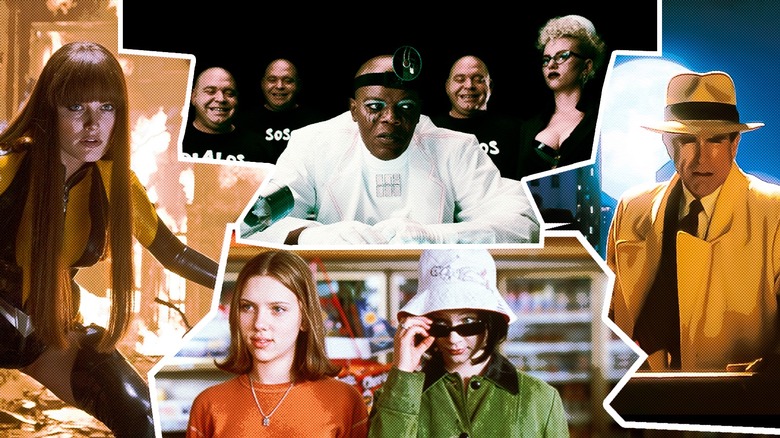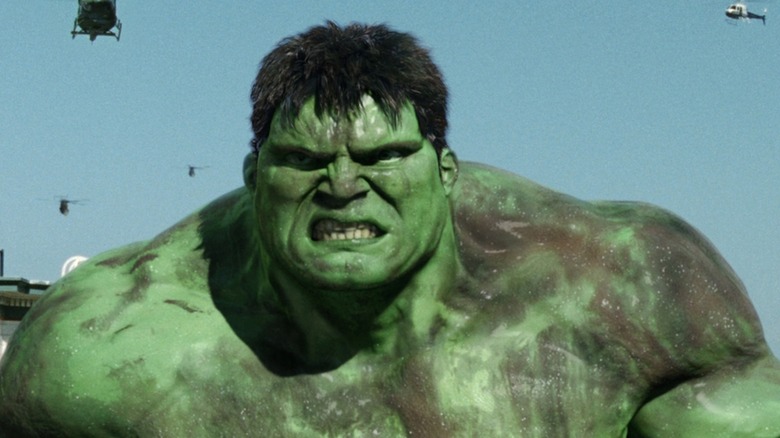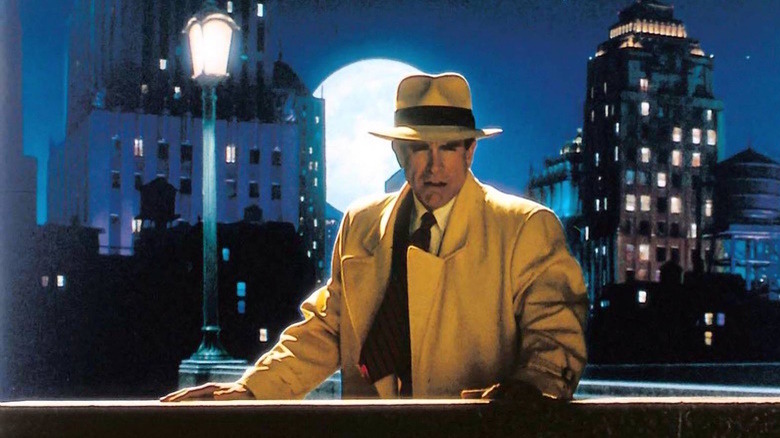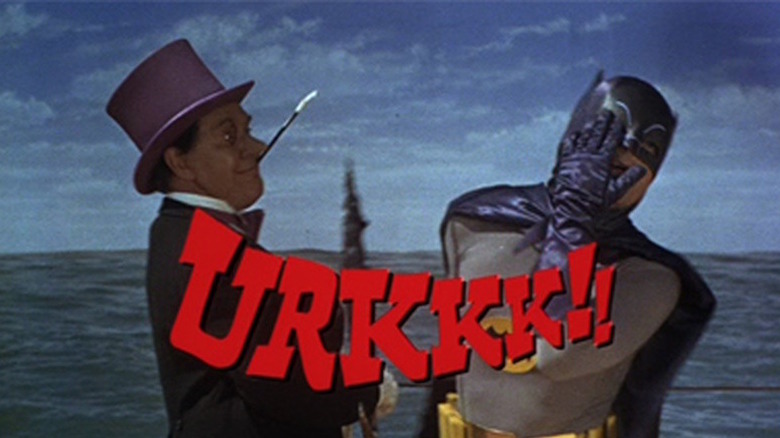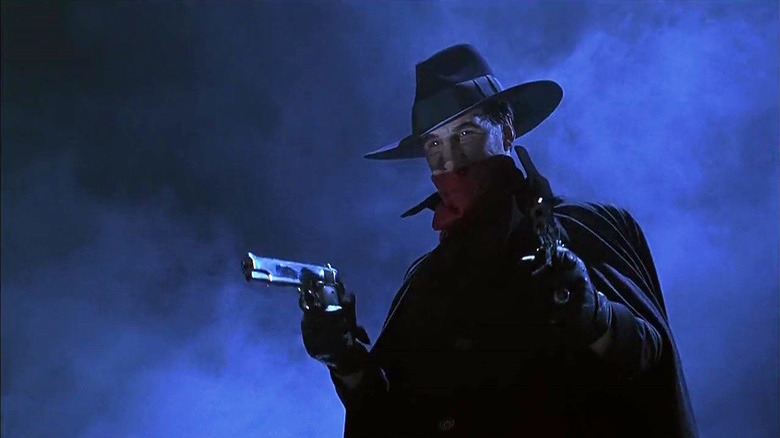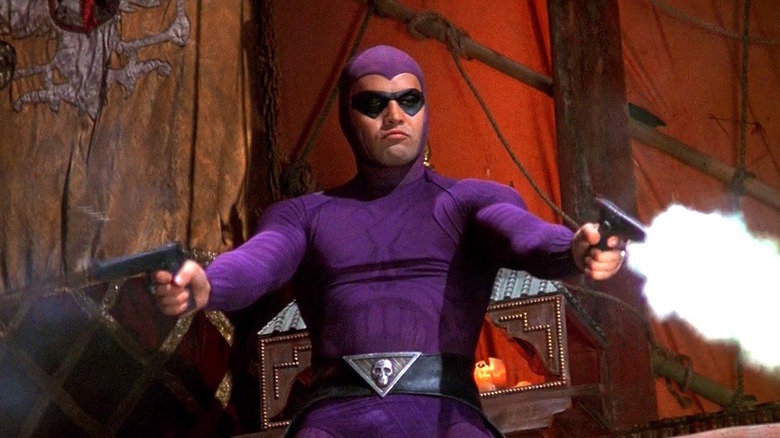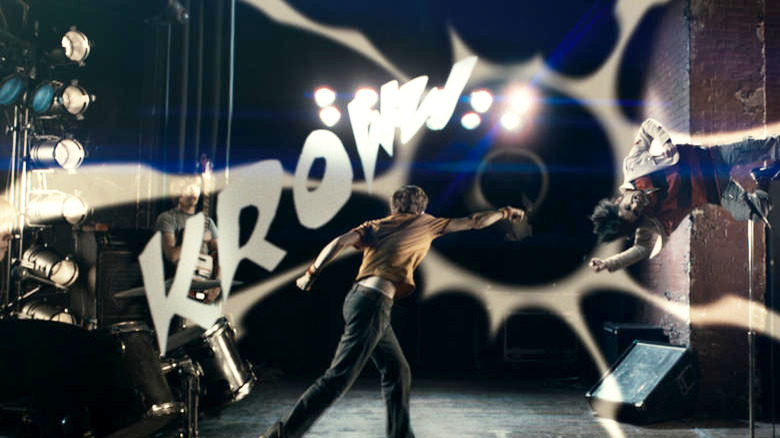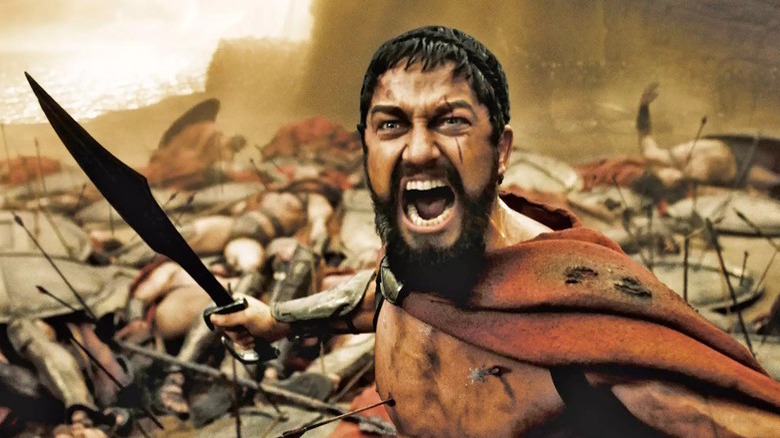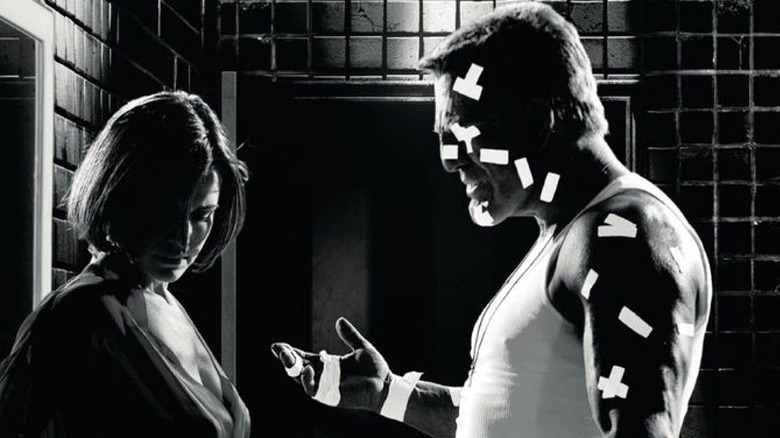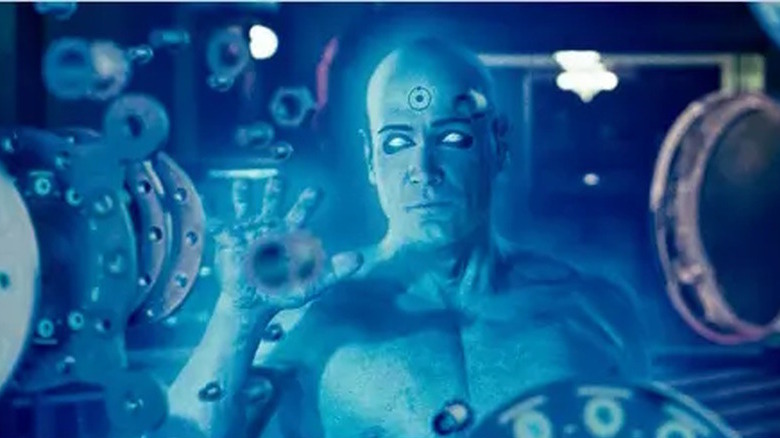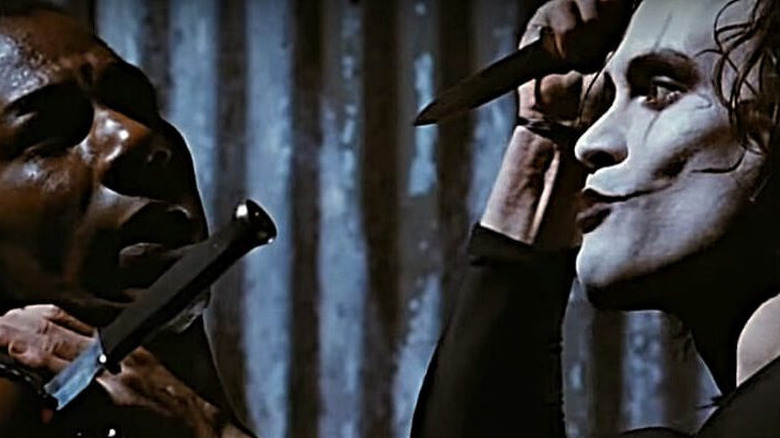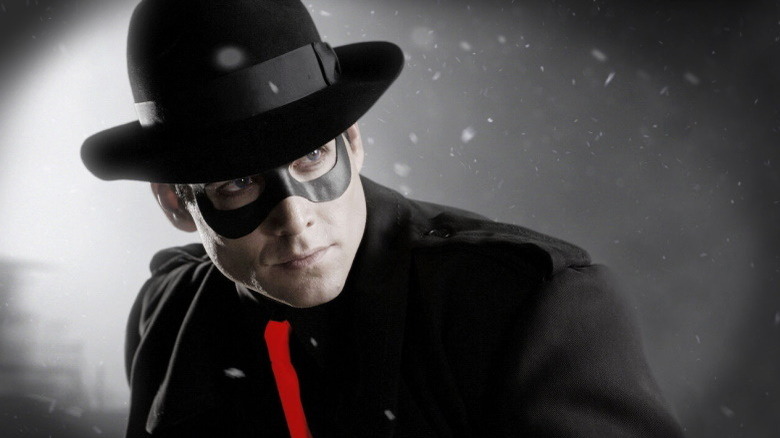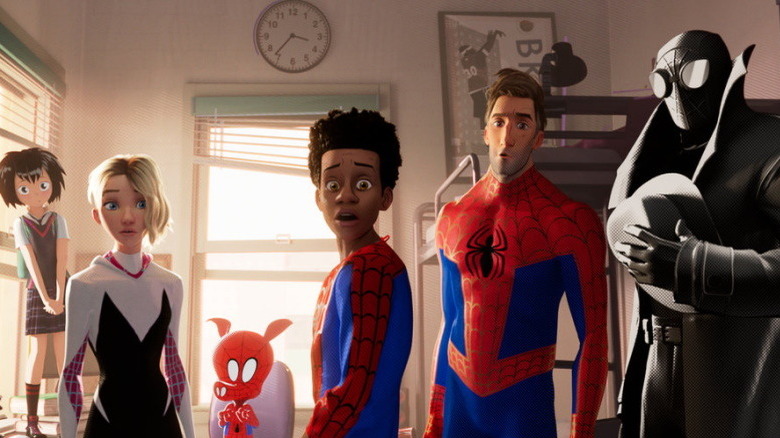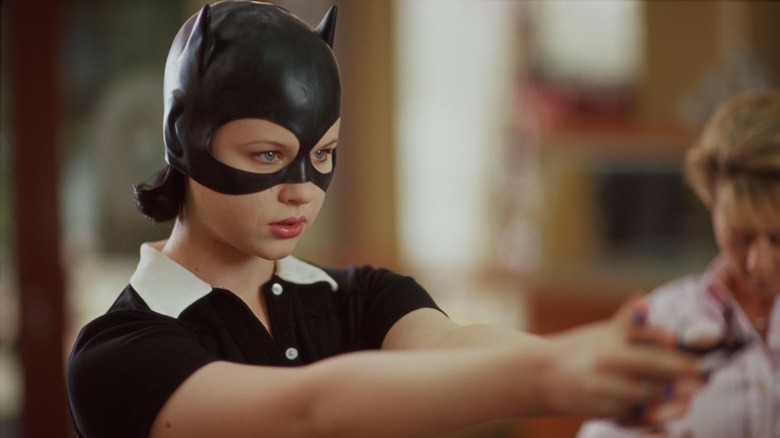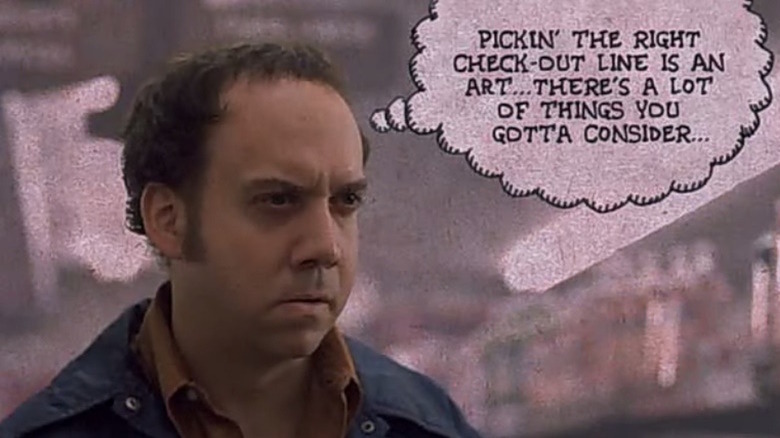Movies That Actually Look Like Comic Books On Screen
Adapting a comic book into a movie can be quite challenging. While superheroes, mythical warriors, and manga characters may look great as two-dimensional drawings, directors typically try to ground their story in some sort of cinematic reality. This often means dressing characters in less outlandish costumes, toning down big personalities, and generally removing most of the fantastical elements from the original story.
Sometimes though, directors choose to lean heavily into the source material instead, marrying their vision with the original comic book art. Results vary, with some films resulting in confused, unfocused narratives. Other times, however, audiences get to enjoy jaw-dropping visuals embraced as genuine cinematic achievements. This was the case with "Spider-Man: Into the Spider-Verse" (2018), which won best animated feature award at the 91st Academy Awards.
With hopes that "Spider-Man: Across the Spider-Verse" can replicate that success, here's a look back at some other films that attempted (and in some cases, succeeded) in slavishly translating the look of comic books to the big screen.
Hulk (2003)
Director Ang Lee attempted to give his audience the experience of reading a comic book when he made 2003's "Hulk." The film divides the screen into multiple panels at various times, each with its own separate shot. This allowed audiences to experience the Hulk's rampages from multiple angles simultaneously, as if they were looking at a page of moving comic book art.
As a cinematic experiment, Lee's artistic choices were bold and somewhat risky, particularly for such a mainstream blockbuster. Some critics suggested his vision should be studied by other superhero filmmakers, but a good portion of the audience found it one of many reasons the entirety of the experience was jarring. Viewer attention was constantly being pulled in multiple directions at the same time, making it difficult to follow the story. Most comic book readers focus on one panel at a time, after all, and seeing so much action on the screen gave many movie viewers headaches.
"Hulk" also dealt with some genuinely dark material by delving into Bruce Banner (Eric Bana)'s traumatic childhood, yet would occasionally trade its somber tone for a moment of comic book-inspired levity. At one point, Banner's nemesis Glenn Talbot (Josh Lucas) gets caught in an explosion and becomes a person-shaped panel as he freezes in mid-screen and gets consumed by the flames. It's a memorable visual, but also a goofy one that doesn't fit with the rest of the movie, leaving "Hulk" a confounding film, even two decades later.
Dick Tracy (1990)
"Dick Tracy" (1990) wasn't the first movie adaptation of the comic strip detective. There were numerous Dick Tracy movie serials made during the 1930s, and RKO Radio Pictures released a whole series of "Dick Tracy" action films in the 1940s.
But 1990's "Dick Tracy" stands out since director Warren Beatty (who also plays the title role) wanted to make the film an homage to the 1930's newspaper comic strip. Beatty chose to limit the film's color palette to seven colors — including bright red, green, blue, and yellow — to mimic the look of an old-fashioned comic strip.
This meant A-list actors like Al Pacino, Dustin Hoffman, and Beatty spent the movie dressed in garish yellow, red, and blue suits or lit in dramatic silhouettes. This also meant that the sets were designed in primary colors, often appearing two dimensional in some scenes. Beatty's Dick Tracy even fought in a comic strip-like style — taking out multiple goons with one punch or causing a crook to backflip after taking a hit.
The makeup artists also based almost all their designs on the drawings of "Dick Tracy" creator Chester Gould. This was particularly true for the rogue's gallery, which included cartoonishly ugly characters like hitman Flattop (William Forsythe), deformed crime boss Pruneface (R.G. Armstrong), and The Brow (Chuck Hucks), a criminal with a huge wrinkled forehead. While some critics and audiences couldn't decide whether this new "Dick Tracy" film looked grand or silly, it's comic strip-style look was inarguably unforgettable.
Batman: The Movie (1966)
The 1960's "Batman" TV show starring Adam West and Burt Ward was initially a huge hit on television, and it had a sizable impact on how people came to see both Batman and comic books in general. Created as a campy version of DC's "Batman" comic books, the TV series regularly put its hero in overly elaborate death traps and gave him silly gadgets like "Shark Repellant Bat-Spray." Whenever Batman and Robin got into a fight, the screen would suddenly explode with animated sound effects and exclamation-point-laden gibberish like "POW!" "BAM!" and "ZONK!" punctuating the punch, just like in a comic book.
All this pop-art inspired imagery was carried over for 1966's "Batman: The Movie." The feature length film saw the Dynamic Duo trying to save the U.N. from the Joker (Caesar Romero), Riddler (Frank Gorshin), Penguin (Burgess Meredith), and Catwoman (Lee Meriwether, who replaced Julie Newmar from the TV show). Fans were treated to several iconic scenes, including a meme-worthy moment where Batman runs around the city repeatedly trying (and failing) to get rid of a bomb.
Given how dark "Batman" movies have become today, it may seem unbelievable that "Batman: The Movie" presented the "Dark Knight" as such as goofy character; in many ways, the sizable shadows cast by West and Ward killed any hope of reviving the character in live action until Tim Burton came along. Nowadays, West's "Bright Knight" has become an iconic character in his own right, and many modern Batman films have paid homage to the classic 1960's television show. West and Ward even returned to voice their characters in the animated "Batman: The Return of the Caped Crusaders" (2015) and "Batman vs. Two-Face" (2017), shortly before West's death in 2017.
The Shadow (1994)
The Shadow is a unique superhero since he has roots in multiple pop culture media. Originally the narrator of the 1930s radio program "Detective Story Hour," the Shadow became the star of his own radio drama series, pulp magazine, comic book, and multiple feature films. In 1994, "The Shadow" movie paid homage to many of these mediums.
Set in the late 1920s, the film follows former drug warlord Lamont Cranston (Alec Baldwin), who learns how to "cloud men's minds" in Tibet and uses his stealth skills to take down the New York City underworld. This causes him to come into conflict with Shiwan Khan (John Lone), who wants to take over the world using his own psychic abilities and an early atomic bomb.
The film's set design, lighting, and costumes mimic the look of The Shadow's vintage comic books, with many shots highlighting the character's distinctive silhouette. The Shadow's eerie voice and haunting laugh also resemble his classic radio drama voice. At one point, the filmmakers even included a reference to the sponsor ads radio dramas used to sneak into their scripts by having Shiwan Khan compliment Cranston on his Brooks Brothers tie and ask him where he got it.
While "The Shadow" was not a critical or commercial success, it has acquired a cult following and helped interest many people in the classic pulp heroes of the 1930s. There has even been talk of a reboot for "The Shadow" which, given the current popularity of comic book adaptations, could play much better today than in the 1990s.
The Phantom (1996)
Released a couple years after "The Shadow," "The Phantom" is another largely-forgotten movie about a comic strip character from the 1930s. Interestingly, the Phantom is a superhero with a somewhat "realistic" backstory. Rather than being imbued with superpowers, "The Phantom" is a legacy passed down from father to son (and occasionally daughter). This gives the Phantom the illusion of immortality, although he's a regular human with no special abilities.
However, 1996's "The Phantom" movie leaned heavily into the source material's more fantastical elements. This included dressing the film's lead Billy Zane in a skintight purple outfit and domino mask straight out of the original comic strip. He also chats with his father's ghost and displays an insane level of politeness — at one point he stops chasing a fleeing suspect in order to return a purse to a random woman. The plot itself had the villain attempt to combine the three "Skulls of Toguganda" to gain mystical powers, only to discover the Phantom's Skull Ring can control their power.
Critics were divided on the film's attempts to recreate the flavor of classic pulp adventure stories, although the movie did achieve something of a cult following. Zane himself gained more notoriety a year later when he played Kate Winslet's arrogant fiancé Caledon Hockley in "Titanic" (1997). Other animated series and television shows have attempted to bring back the Phantom, but he has largely remained in the funny pages.
Scott Pilgrim vs. The World (2010)
"Scott Pilgrim" was originally a series of graphic novels by Canadian writer/artist Bryan Lee O'Malley. Influenced by the look of Japanese shonen-style manga comics, the story followed a Toronto slacker who falls in love with American delivery girl Ramona Flowers and must battle her seven evil exes to date her. The fights and Ramona's exes are intentionally cartoonish, particularly her ex-boyfriend Todd, who gained psychic powers by becoming a vegan.
The series was adapted by Edgar Wright into the 2010 romantic action-comedy film "Scott Pilgrim vs. the World," starring Michael Cera as Scott and Mary Elizabeth Winstead as Ramona. The movie intentionally mimicked the look of manga comics, with flashback sequences shown as literal moving panels from the comic book. Words describing the impact of blows spontaneously appeared during fights, much like the 1960's "Batman" series. Actors posed like manga characters, pointing dramatically at their opponents and breaking into elaborate dances.
The movie also drew inspiration from classic 16-bit video games, with the words "K.O." appearing whenever Scott scored a win. One fight was even shot on a pyramid tower, resembling the one from "Super Mario Bros." To top it off, at the end of each fight, the defeated ex would burst into coins, which Scott could collect. Like some other slavishly-loyal comic book-style movies, "Scott Pilgrim vs. the World" was a box office bomb, yet has acquired a cult following in people who appreciate its unique, creative look.
300 (2006)
Given how outlandish many comic book-style films look on screen, it's easy to believe filmmakers need to dress characters in bright outfits and make use of flashy gimmicks like animated sound effects to recreate the feel of a cinematic comic book. But graphic novels also make use of somber, gritty elements and it can be effective when they are translated cinematically.
Frank Miller and Lynn Varley's 1998 comic book series "300," for instance, is an epic fictional retelling of the Battle of Thermopylae during the Greco-Persian Wars. The comic art was intentionally painted in dark tones by Varley to convey the grim nature of war, with many dramatic angles of men being thrown off cliffs or stabbed by spears. The look was so distinctive that the 2006 film adaptation decided to offer a shot-by-shot adaptation of the comic. The film made director Zack Snyder a superstar, as he actually photocopied panels from the original comic book to plan how he would frame each shot.
Post-production and visual effects teams also altered the footage to convey the look of the graphic novel more closely, not only in background elements but in how the film's colors were tinted to increase the contrast between light and dark elements. The result had a distinctive grittiness that felt simultaneously like live action and animation.
Sin City (2005)
One year before "300," comic book writer and artist Frank Miller adapted several books from his graphic novel series "Sin City" alongside director and producer Robert Rodriguez. The film, which follows multiple criminals, prostitutes, mercenaries, police officers, and mob enforcers as they run amok through corrupt Basin City, was unlike anything audiences had seen before.
Much like "Dick Tracy" before it, "Sin City" stars an ensemble cast of well-known actors including Jessica Alba, Benicio del Toro, Mickey Rourke, Bruce Willis, Elijah Wood, and others. Unlike "Dick Tracy," the tone of "Sin City" is decidedly not cartoonish — although it does mimic the graphic novel's unique color scheme.
Rather than overwhelm the audience with bright colors, most of the film is rendered in black and white. However, it does retain or add color to selected objects, drawing the viewer's attention to key items like the flames of an explosion or the blood from a thug's wounds. Rodriquez was so adamant about staying faithful to the source material that no screenwriter is shown in the credits, instead the film is "Based on the graphic novels by Frank Miller." Only certain scenes showing nudity or excessive violence were edited from the original story, although many of these were re-edited into the Collectors DVD.
While some audiences were unnerved by the extreme violence in "Sin City," the movie's distinctive look reveals how films can successfully adapt other elements from graphic novels into movies. A decade later the film finally yielded a long-gestating, underwhelming sequel, "Sin City: A Dame to Kill For," although it was not as well received.
Watchmen (2009)
Say what you will about Zach Snyder, but the man knows how to replicate comic book imagery on the big screen. Just look at "Watchmen" (2009), an adaptation of Alan Moore's beloved limited series. As he did with "300," Snyder used comic book artist Dave Gibbons' artwork as a basis for his storyboards. This gave the film a very comic book-like look, particularly in the scenes that cover the transformation of Jon Osterman (Billy Crudup) from human scientist into the omnipotent Doctor Manhattan.
Alterations were made to the original comic's storyline, including a major (some fans might argue, unforgivable) change in the final act. Some of the characters' appearances also differ somewhat from their comic book counterparts, and there's actually a lot more action in the fight scenes compared to Moore and Gibbons' comic book. Moore, notoriously anti-Hollywood, used the word "pointless" in describing most comic book movies to Entertainment Weekly in 2008. "There are things that we did with 'Watchmen' that could only work in a comic," he said. "[They] were indeed designed to show off things that other media can't."
Nevertheless, many viewers consider the "Watchmen" film to be one of the most faithful movie adaptations of a comic book ever made, at least in terms of visual style. The film continues to draw fans, and a critically-acclaimed live action HBO "Watchmen" limited series was released in 2019 and similarly impressed.
The Crow (1994)
"The Crow" is perhaps best remembered today for its notorious place in dark Hollywood history; star Brandon Lee was accidentally shot and killed while filming one of its scenes. This caused the film to be rewritten on the fly, with Lee replaced by a stunt double and early digital effects employed to finish his performance.
However, at the time of the tragedy "The Crow" (and eventual "Dark City" director Alex Proyas) was already well on its way to establishing a unique, darkly haunting visual style that has influenced numerous films since. Using miniatures and lighting effects, the filmmakers constructed a grungy city for resurrected vigilante Eric Draven to make his stomping grounds, doling out his a harsh brand of justice to his killers. Much use is made of shadows and extreme-angle shots, similar to film noir-style comic books. The editing is extremely fast, evoking the quick pace of comic book action sequences (as well as music video-style storytelling).
The film has a washed out-quality that makes certain shots almost black-and-white (but not quite), mimicking the look of the original black-and-white graphic novel. The movie proved quite popular despite its unfortunate production; throughout the '90s and beyond, teens could be seen wearing "Crow" t-shirts and posters in dorm rooms. Subsequent attempts to continue that success (straight-to-DVD movies, a short-lived TV series) have never been able to recapture the magic — or the haunting aesthetic of the Proyas film.
The Spirit (2008)
Originally a 1940s newspaper comic strip by Will Eisner, "The Spirit" followed the exploits of a masked vigilante who fought crime in "Central City" and frequently took on the criminal mastermind dubbed "The Octopus." The Spirit would continue to resurface in later stories throughout the decades, even crossing into the DC Universe in the one-shot crossover "Batman/The Spirit."
In 2008, hot off the success of "300" and "Sin City" and with Hollywood friends like Robert Rodriguez touting his talents, Frank Miller stepped into the director's chair, attempted to bring "The Spirit" to the big screen with a cast that starred Gabriel Macht as the Spirit, Samuel L. Jackson as the Octopus, and Scarlett Johansson as Octopus accomplice Silken Floss. Miller wrote and directed the film and took pains to give it a comic book feel similar to "Sin City," similarly filming the actors predominantly in front of green screens that allowed him to create a black-and-white world punctuated by bursts of color. Parts of the characters' costumes were also animated, giving them an intentional two-dimensional look.
Unfortunately, while the end result was visually stunning, audiences didn't care for many of Miller's other creative choices, particularly the Spirit's weird monologues about Central City where he referred to the city as "my lover" and "my mother." Most of the performances and fight sequences were very over-the-top — at one point, Jackson's flamboyant Octopus smashes the Spirit with a random toilet while screaming, "Toilets are always funny!" Today, some fans enjoy viewing the film as an unintentional spoof on old-school superheroes, but overall, the movie was never able to find its audience.
Spider-Man: Into the Spider-Verse (2018)
While most of the movies on this list are live action films that use animation sparingly to enhance the look of their narratives, "Spider-Man: Into the Spider-Verse" is a completely computer-animated film that fully embraces its drawn narrative to depict a living comic book that follows Miles Morales (Shameik Moore) as he adjusts to being his dimension's new Spider-Man.
It works brilliantly. While comic book conventions like captions, animated sound effects, and moving panels can look jarring in live action, they register very differently in animation. Viewers are more accepting of an abstract filmmaking style, so when they see a giant "Look Out!" sound effect appear behind Miles to represent his spider-sense, it seems both natural and dramatic. The art style evokes both classic comic books and a graffiti-inspired look, so the bright vivid colors and lighting don't look as out-of-place as the color scheme in "Dick Tracy."
Special mention should also be made for the different Spider-Men (and women, and pigs) who get pulled out of their own dimensions to team-up with Miles. Since each character comes from their own dimension, filmmakers Bob Persichetti, Peter Ramsey and Rodney Rothman chose to depict them in their own art style, including a manga-influenced "Peni Parker," (Kimiko Glenn), Looney Tune-esque "Spider-Ham" (John Mulaney), and black-and-white "Spider-Man Noir" (Nicolas Cage). Having so many art styles intentionally clashing with each other would normally look awkward; here, it just looks incredibly cool.
Ghost World (2001)
Not all comic books are action-packed epics filled with superheroes. Some, like Daniel Clowes' cult classic "Ghost World," simply tell the day-to-day lives of pseudo intellectual girls who enjoy criticizing pop culture and the people in their generic American town. Nevertheless, the graphic novel has a distinct art style with its washed-out coloring and focus on the town's changing shopping malls and fast food restaurants.
This vision was translated into a 2001 film adaptation of "Ghost World" via a script co-written by Clowes and director Terry Zwigoff. Wanting to establish a comic book aesthetic different from "Dick Tracy" or superhero movies, the filmmakers chose to slightly oversaturate the film, enhancing the coloring not to the point of other comic book-style movies, but enough to draw the audience's attention.
Efforts were also made to have the two leads (played by Thora Birch and a young Scarlet Johansson) mimic the look of the girls in the comic, particularly with Birch's glasses and bobbed hair. The streets were also left intentionally empty of extras, creating an eerily vacant feel that mimics the alienation explored in the comic. While such creative choices are subtle, they coalesce in a comic book reality like none other.
American Splendor (2003)
"American Splendor" occupies a unique space in comic books. Not only is it a non-superhero independent comic that depicts the drama of real life, it also tells the true tale of its creator Harvey Pekar, who even chronicles the story of his battle with lymphoma in its offshoot, "Our Cancer Year." The stories have been adapted into multiple theatrical productions and in 2003, documentary filmmakers Shari Springer Berman and Robert Pulcini turned the comics into a movie starring Paul Giamatti as Pekar.
Not surprisingly, the film uses documentary segments where the real Pekar and his wife Joyce Brabner discuss their lives. However, the movie also includes comic book-style sequences, including moments where you see thought balloons appear over Pekar's head. Pekar's black-and-white comic book self also appears as an animated figure to goad his narrative self into action.
At other moments, a live action Pekar breaks the fourth wall while wandering through a drawn landscape made up to look like the images from his comic book. It's not quite "Deadpool," yet it shows how some comic book stories don't need to rely on flashy action sequences or bright costumes to engage, entertain and transcend its panel-dependent pages of origin.
